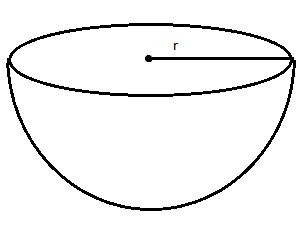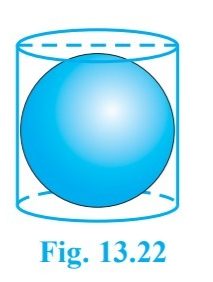NCERT Solutions Class 9 Maths
Chapter – 13 (Surface Areas and Volumes)
The NCERT Solutions in English Language for Class 9 Mathematics Chapter – 13 Surface Areas and Volumes Exercise 13.4 has been provided here to help the students in solving the questions from this exercise.
Chapter 13: Surface Areas and Volumes
- NCERT Solution Class 9 Maths Ex – 13.1
- NCERT Solution Class 9 Maths Ex – 13.2
- NCERT Solution Class 9 Maths Ex – 13.3
- NCERT Solution Class 9 Maths Ex – 13.5
- NCERT Solution Class 9 Maths Ex – 13.6
- NCERT Solution Class 9 Maths Ex – 13.7
- NCERT Solution Class 9 Maths Ex – 13.8
- NCERT Solution Class 9 Maths Ex – 13.9
Exercise – 13.4
1. Find the surface area of a sphere of radius:
(i) 10.5cm
(ii) 5.6cm
(iii) 14cm
(Assume π = )
Answer –
(i) Radius of the sphere, r = 10.5 cm
Surface area of the sphere = 4πr2
= 4 × × 10.5 cm2
= 1386 cm2
Surface area of the sphere is 1386 cm2
(ii) Radius of the sphere, r = 5.6cm
Surface area of the sphere = 4πr2
= 4 × × 5.6 cm2
= 394.24 cm2
(iii) Radius, r = 14 cm
Surface area of the sphere = 4πr2
= 4 × × 14 cm2
= 2464 cm2
2. Find the surface area of a sphere of diameter:
(i) 14 cm
(ii) 21 cm
(iii) 3.5 cm
(Assume π = )
Answer –
(i) Radius of sphere, r = diameter/2 = 14/2 cm = 7 cm
Surface area of a sphere = 4πr2
= 4 × × 7cm × 7cm
= 616 cm2
Surface area of the sphere is 616 cm2
(ii) Radius of the sphere, r = diameter/2 = 21/2 = 10.5 cm
Surface area of a sphere = 4πr2
= 4 × × 10.52
= 1386
Surface area of the sphere is 1386 cm2
(iii) Radius of sphere, r = diameter/2 = 3.5/2 = 1.75 cm
Surface area of a sphere = 4πr2
= 4 × × 1.752
= 38.5
Surface area of the sphere is 38.5 cm2
3. Find the total surface area of a hemisphere of radius 10 cm. [Use π=3.14]
Answer –
Radius of the hemisphere, r = 10 cm

The total surface area of a hemisphere = (4πr2)/2 + πr2 = 3πr2
= 3 × 3.14 × 102
= 942
The total surface area of the given hemisphere is 942 cm2.
4. The radius of a spherical balloon increases from 7cm to 14cm as air is being pumped into it. Find the ratio of surface areas of the balloon in the two cases.
Answer –
The radius of the balloon before pumping air, r₁ = 7cm
The radius of the balloon after pumping air, r₂ = 14cm
The surface area of the balloon before pumping air, SA₁ = 4π(r₁)2
The surface area of the balloon after pumping air, SA₂ = 4π(r₂)2
The ratio of the surface areas of the balloon, = SA₁/CSA₂
= 4π(r₁)2/4π(r₂)2
= (r₁)2/(r₂)2
= (r₁/r₂)2
= (7/14)2
= (1/2)2
= (1/4)
The ratio of the surface areas of the balloons = 1: 4
5. A hemispherical bowl made of brass has inner diameter 10.5cm. Find the cost of tin-plating it on the inside at the rate of Rs 16 per 100 cm2. (Assume π = )
Answer –
Inner diameter, d = 10.5 cm
Inner radius, r = d/2 = 10.5/2cm = 5.25 cm
CSA of hemispherical bowl = 2πr2
= 2 × × 5.25 cm × 5.25 cm
= 173.25 cm2
The cost of tin-plating 100 cm2 of the bowl = ₹16
The cost of tin-plating 1 cm2 of the bowl = ₹16/100
The cost of tin-plating 173.25 cm2 area of the bowl = (₹16/100) × 173.25 = 27.72
Thus, the cost of tin-plating is ₹ 27.72.
6. Find the radius of a sphere whose surface area is 154 cm2. (Assume π = )
Answer – Let the radius of the sphere = r
The surface area of the sphere = 154 cm2
4πr2 = 154 cm2
r2 =
r2 =
r2 =
r2 =
r = = 3.5 cm
Thus, the radius of the sphere whose surface area is 154 cm2 is 3.5 cm.
7. The diameter of the moon is approximately one fourth of the diameter of the earth. Find the ratio of their surface areas.
Answer –
Let the radius of the earth = R
the radius of the moon = r
Diameter of the moon = 1/4 × diameter of the earth
Thus, the radius of the moon = 1/4 × radius of the earth [Since, radius = 2 × Diameter]
r = 1/4 × R
r/R = 1/4 ———— (1)
Now, the surface area of earth = 4πR2
The surface area of moon = 4πr2
The ratio of their surface areas = 4πr2/4πR2
= r2/R2
= (r/R)2
= (1/4)2 [From equation (1)]
= 1/16
The ratio of their surface areas = 1 : 16
8. A hemispherical bowl is made of steel, 0.25 cm thick. The inner radius of the bowl is 5cm. Find the outer curved surface of the bowl. (Assume π = )
Answer – The inner radius of the bowl, r = 5 cm
Thickness of steel = 0.25 cm
Outer radius of the bowl, R = 5 cm + 0.25 cm = 5.25 cm
Outer CSA of the hemisphere = 2πR2
= 2 × × 5.25 cm × 5.25 cm
= 173.25 cm2
Thus, the outer curved surface area of the hemisphere is 173.25 cm2.
9. A right circular cylinder just encloses a sphere of radius r (see fig. 13.22). Find
(i) surface area of the sphere,
(ii) curved surface area of the cylinder,
(iii) ratio of the areas obtained in(i) and (ii).

Answer –
The radius of the sphere = Radius of the cylinder = r
Height of the cylinder, h = diameter of the sphere = 2r
Thus, h = 2r
(i) Surface area of sphere = 4πr2
(ii) Height of cylinder, h = r + r = 2r
Radius of cylinder = r
CSA of cylinder formula = 2πrh = = 2πr × 2r
= 4πr2
(iii) Ratio between areas = (Surface area of sphere)/(CSA of Cylinder)
= 4πr2/4πr2 = 1/1
Thus, the surface area of the sphere and the curved surface area of the cylinder is 4πr2 and the ratio between these areas is 1 : 1.

Leave a Reply